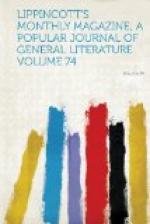Religion, too, was another point on which the forces of new and old met in collision. Madame was of course what is meant by the word “religious.” Like all persons trading on falsehood and living in deception, her orthodoxy was undoubted, and the most rigid investigation could not have discovered an unsound spot anywhere. She would as soon have thought of questioning her own existence as of doubting the literal exactness of the first chapter of Genesis, and she thought science an awfully wicked thing because it went to disprove the story of the six days. She firmly believed in the personality of Satan and material fires for wicked souls; and the sweet way in which she lamented the probable paucity of the saved was extremely edifying, not to say touching. This childlike acceptance, this faithful orthodoxy, was one of the things for which the rector liked her so well. He had a profound contempt for science and skepticism together; and an unbeliever, even if learned in the stars and old bones, ranked with him as a knave or a fool, and sometimes both. His pet joke, which was not original, was that there was only one letter of difference between septic and skeptic, and of the two the skeptic was the more unsavory.
Being then pious, madame had hung about her walls short texts in fancy lettering, with a great deal of scroll-work in gold and carmine to make them look pretty. When she came into possession of Leam’s mind, she was shocked at her ignorance of all the sayings that were so familiar to herself and other persons of respectability. Leam knew nothing but a few barbarous prayers to saints, used more after the fashion of charms than anything else, the ave and the paternoster said incorrectly and not understood when said. Wherefore madame caused to be illuminated some texts for her room too, as lessons always before her eyes, and counter-charms to those heathenish invocations in which the child put her sole faith and trust of salvation. And among other things she gave her the Ten Commandments, very charmingly done. Round each commandment were pictures, emblems, symbolic flowers, all enclosed in fancy scroll-work of an elaborate kind. Really, it was a very creditable piece of bastard art, and Mr. Dundas was moved almost to tears by it. Madame did it herself—so she said with a tender little smile—as her pleasant surprise for poor dear Leam on her fifteenth birthday. And Leam was so far tamed in that she suffered the Tables to be hung up in her bedroom, and even found pleasure in looking at them. The pictures of Ruth and Naomi; of the thief running away with the money-bags; of a woman lying prostrate with long hair, and a broken lily at her side; of a murdered man prone in the snow, and a frightened-looking bravo, half covering his face in his cloak, fleeing away in the darkness, with a bowl marked “poison” and a dagger dripping with blood in the margin,—all these pictures, which stood against the commandments they illustrated, fascinated her greatly. The




